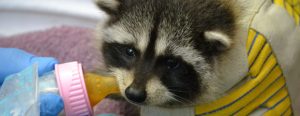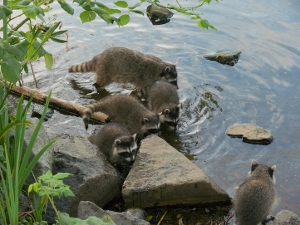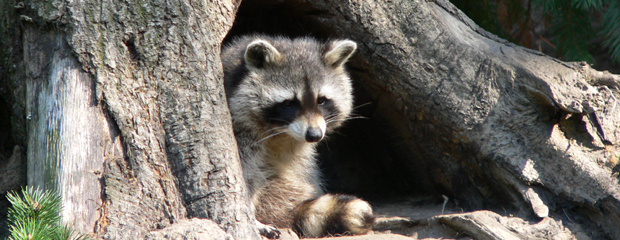MARS Moment May, 2011
by Sandy Fairfield, MARS Education Coordinator

Baby Racoon
Our spring continues to be very slow to warm up and this has meant a late start for many wildlife species.
Last week the first baby mammal arrived at MARS: the tiny “masked bandit” was unmistakably a Raccoon. These highly intelligent, curious, mischievous, nocturnal creatures have highly developed senses of smell, hearing and touch, and rival humans in their manual dexterity.
Large black eyes that peer out from black face masks and black-and-gray ringed tails make identification of these creatures very easy. Raccoons have long dense fur which is a combination of gray, black and white. Short front legs give Raccoons a hunched over appearance when they are walking, but this allows them to sit up straight when eating their food. Their flat back feet have five dextrous toes tipped with sharp strong claws which enables them to be nimble tree and fence climbers; it is remarkable how fast they can move when alarmed. The shorter front feet are used just like hands to collect and hold food or pry open shellfish on the beach.
Classified as omnivores (they will eat anything they fancy) Raccoons are opportunistic feeders devouring pretty much anything that is edible. Favourite foods for these animals are eggs ~ which they they climb up the trees to steal from nesting avian species ~ but they will also hunt for small mammals, insects, birds and fish and are very happy to pick over human garbage for any tasty morsels or steal a chicken from the coop!
Mating takes place between January and March; once successfully mated the female will aggressively chase away the male leaving her in full control of raising the young. Three or four “kits” are normal for a Raccoon family. The mother is highly protective of her young and will attack a predator or any other intruder she feels threatened by, which includes humans.
Baby Raccoons weigh only three ounces at birth, their eyes and ears are closed, their fur sparse making them totally dependent on their mother for the first nine to twelve weeks of life. It is critical for the health and welfare of these kits to be with the mother who nurtures them and then begins passing on her highly complex hunting skills; they will stay together as a family for their first year.
Baby wildlife especially Raccoons, fawns and seal pups, are irresistibly cute and each year MARS rescues or receives “kidnapped” babies. On arrival at our centre the young need to be fed every 30 minutes and their diet must be as close as possible to the diet provided by the mother as the first few weeks of life are crucial for healthy development. We do not have the necessary long-term housing to rehabilitate mammals, so the Raccoons are sent to Wild ARC (Animal Recovery Centre) in Victoria, the seal pups to the Vancouver Aquarium or Saltspring Island and the fawns are raised on local acreage until they can join the herd.
Raccoons can change rapidly from being warm fuzzy babies to highly unpredictable aggressive juveniles. They also pose another concern in urban areas as they can carry diseases that can be transmitted to humans. They should not be encouraged around your property and certainly not be fed as pets.
A few things you can do to deter Raccoons from your property are: ensure all garbage is tightly enclosed; barbecues should be cleaned and covered; and any out buildings that may be attractive as nest sites should be decluttered.
A reminder: MARS does not provide a “relocation service” for unwanted Raccoons or other wildlife pests such as starlings, rabbits or pigeons, but we can offer advice. Please call us before intervening with any wildlife species, especially the babies: very often they are not orphaned; the parents are away hunting and will return. Wildlife babies’ best chance for survival is with their parents.
For more information, call 250-337-2021
To report injured wildlife please call toll-free at 1-800-304-9968.

